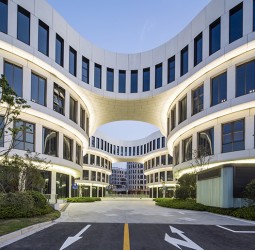建筑设计 : Tomoyuki Kurokawa Architects
项目名称:Kitasenzoku公寓
项目地址 : 日本 东京 大田区
建筑结构 : 钢筋混凝土
占地面积 : 145.78平米
建筑面积: 97.72平米
总建筑面积:490.07平米
摄影 : Takumi Ota
项目最初,业主希望设计师能在东京工业大学的周边建造一幢综合性建筑,如美国硅谷那样,为大学、公司及周边城镇打造出一个相互依存的生活圈。建筑师由此命题出发,着手设计了一栋在周边社区内独树一帜的纯白色综合性建筑楼——Kitasenzoku公寓,由业主公司的办公楼、学生宿舍和员工及业主的寓所组成。
“As you find in Silicon Valley of the United States, I would like to produce a model case near Tokyo Institute of Technology, creating and developing a synergistic cycle for this university, companies and the neighboring towns.” This wish of a client was realized as a project to design and build an architectural complex at the site near the university, consisting of the office of the client’s company, the shared-room style student residences, and the residences for the staff members and the client.
Kitasenzoku公寓坐落于东京工业大学旁一个购物区内。入口门厅沿街而建,开放式面向城市,因此这一公共区域可被用来举办学生讲座,同时也可作为城市居民的休闲空间。公共走道从大堂延伸而出,其设计与街道径直相通,里面配备了长凳、照明及植物,构建出一种都市街道的氛围。学生的公共宿舍也同样开放式面向公共走廊,为在此居住的学生们营造出一种更为休闲、温馨的轻松氛围。空间墙面上还涂刷了白板面漆,可以供学生、员工随意涂鸦,不仅为平淡的日常生活增添了不少趣味,还增进了学生与学生之间、员工与员工之间、学生与员工之间的交流和沟通。楼梯后方独立的地道式空间更为学生及员工们提供了一个极佳的私密场所。
This site is located within the shopping district near the university. An entrance hall is situated along with a town street and opened to the city, so that the open area can be used as a lecture space for the students, or as a casual drop-by space for any city residents. The common hallway from the entrance hall is also designed as the extending passage from the town street, equipped with benches, lightings and plants for creating the atmosphere of a city street. A shared space used by the students is also opened to this common hallway, producing a casual and inviting atmosphere for the staff members. The whiteboard paint finish of the wall in this space allows them to draw on the wall, promoting casual and daily discussions among students and staff members. There is a private space for the students separated by the tunnel-like space behind the staircase.
虽然建筑师没有对这幢大楼鲜明的轮廓给出明确的定义,但大楼新颖独特的立面造型并非建筑师的率性所为,而是受到当地对于建筑缩进及阴影投射方面规定的限制,在兼顾建筑的占地面积及居住使用面积后,建筑师给出的设计方案。大楼内部采用了大量的开放式设计,不仅令建筑的体积缩减了不少,还为人们提供了更多交流、沟通的公共空间。阳台便是这种开放式设计的典型代表,它填补了两种立体设计准则之间的间隙。这些设计大胆的阳台并不附属于其中的某一位住客,而是属于居住、工作于Kitasenzoku公寓内的所有人的公用场地,同时也保留了适度的私密性。
The building form was derived from the calculations of setback and shadow-casting regulations, while the volume of the building was defined by the necessary areas and spaces for the residences and users–as a result, balconies are produced as gaps between those two design criteria in three-dimensional manner. While those balconies could be shared by the residents through void spaces with maintaining their own privacies, such three-dimensional condition does not clearly divide the void space into pieces for an attached property of a particular residence.
Because this building has a prominent volume within the surrounding neighborhood, there is no clear and distinguishable front or back side of the building. The building volume is reduced by the sense of openness created by the openings on all elevations of the building.
这幢综合性建筑楼的设计重点是在人与人之间、建筑与城市环境之间建立更紧密的联系,并借此促进业主与住客、住客与住客之间,甚至是学生与城市居民之间更为亲密的交流。
It is intended to design a building focusing on the relationships among people, or a building and the urban environment–and hopefully this building helps develop intimate communication between the client and residents, among residents, and even with the students and city residents to become part of such communication.


